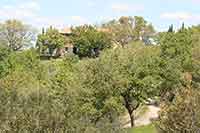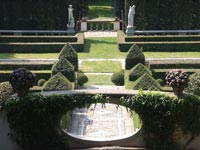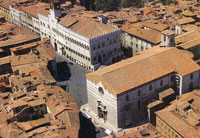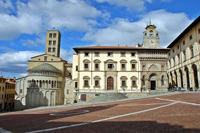| |
|
| |
|
|
|
|
|
|
| |
 |
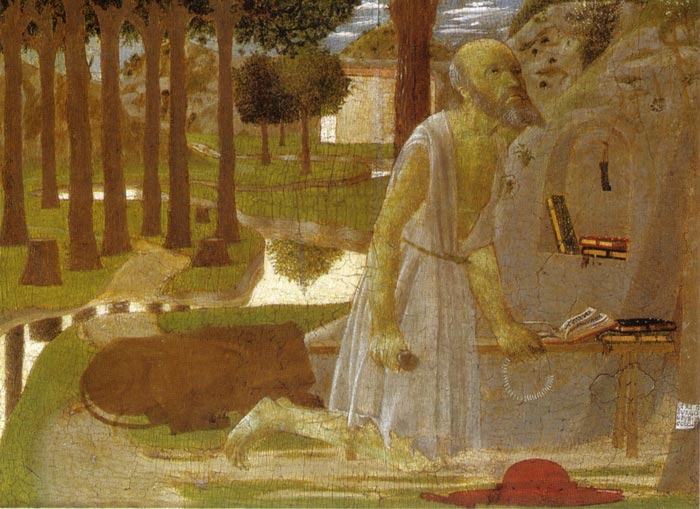 |
|
Piero della Francesca | St. Jerome in Penitence (detail), (c. 1449-1451) - Oil on panel, 51 x 38 cm, Staatliche Museen, Berlin
|
|
 |
|
| |
|
|
|
| |
|
Piero della Francesca | The Penance of St. Jerome (1450), Berlin
|
|
|
|
| |
|
San Girolamo penitente is one of the two paintings by Piero that is dated.[1] The panel was completely repainted in the sixteenth century. The uncompromising 1968 cleaning removed the overpainting which made judgment of the picture impossible. We can now see, in the crystal-clear lighting, behind the hermit saint, a receding background with the perfectly straight tree trunks reflected in the winding river. The clear sky is barely dotted with little white pointed clouds.
St. Jerome, a Father of the Church (ca. 347-420), is said to have spent three years living in retreat in the desert of Chalcis. Previously he had been engaged in studying the sciences in Rome. Western Christianity has him to thank for the translation of the Bible from the Hebrew and Greek into Latin, known as the Vulgate. In accordance with the detailed description of his life in the Legenda Aurea (the important collection of saints' legends), there were two basic ways in which the saint was depicted, both of which appeared in about 1400. One was as a penitent hermit, and the other type - most popular amongst the Dutch - was as a scholar indoors, seated at the desk in his study. This latter method of depiction interpreted the saint as the prototype of the humanist scholar.
Piero decided in favor of a peculiar combination of these iconographical patterns: the rock in front of which St. Jerome is kneeling has a niche in which books and writing implements are contained. The shining red cardinal's hat is lying on the ground, like an implement which is useless in this situation, and is an allusion to the future career of the saint. This part of the composition to a certain extent represents the interior character of the indoor depictions. The rest of the painting is devoted to the landscape, which is anything but a desert: a fertile plain extends behind the penitent, and there is a building in front of the hills in the background. A stream winds its way across the landscape and among the trees, and a path crosses it and winds between the trees into the background.
The gentle colors are presumably a result of the relatively poor state of preservation of the work. It is, however, also possible that this is an early attempt on the part of Piero to develop his own entirely individual colors which create a realistic representation of the atmospheric conditions of a scene under an open sky. The shapes of the clouds are reminiscent of rotating geometrical bodies. We encounter them repeatedly in Piero's works. The colors play at least as important a role in defining the space as the forms. Thus, for example, the brown shades which are rhythmically repeated in the picture and gradually become lighter guide the gaze of the observer through the picture and prompt him to comprehend the spatial relationships. This aspect would in later years become a characteristic of Piero della Francesca's art.
Piero created a further depiction of St. Jerome in the painting of St. Jerome and a Donor, a work which is generally given an earlier date. |
|
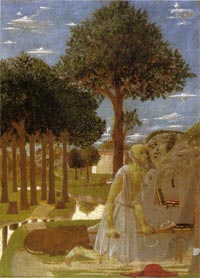
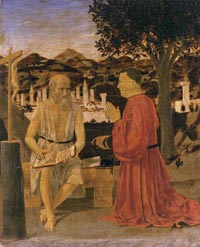 Piero della Francesca, St. Jerome and a Donor Piero della Francesca, St. Jerome and a Donor
|
|
|
|
| |
|
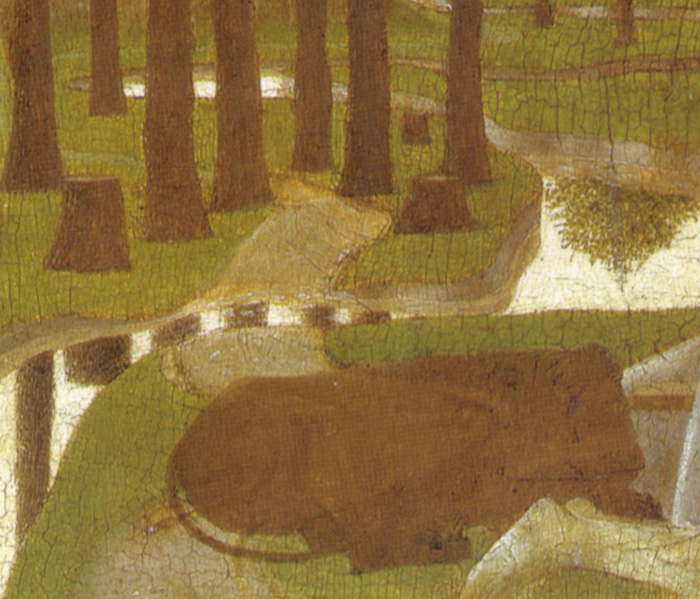 |
Piero della Francesca | St. Jerome in Penitence (detail), (c. 1449-1451) - Oil on panel, 51 x 38 cm, Staatliche Museen, Berlin
According to legend, Jerome removed a thorn from a lion's paw. The lion came to represent fearless devotion to the Christian faith in the saint's iconography or symbolic representation in art.
|

|
|
|
[1] In fact it is Piero's first dated work: the cartellino tacked to the tree trunk which bears the crucifix contains the inscription: PETRI DE BVRGO OPUS MCCCCL. The slight curvature of the chestnut panel (convex like an icon), is probably intentional.
Longhi (1962) did not find the 1450 date credible and proposed a dating around 1440. Effectively, there are strong parallels with the frescoes in the Chiostro degli Aranci in Florence - from which the reflections on the water and the steep banks descend -, while there seems a great distance from the Rimini Fresco, dated 145I.
However it is specifically the geometric form of the river banks, derived from the Master of the Chiostro degli Aranci, that Piero transmitted to Bono da Ferrara in the fresco of Saint Christopher in the Eremitani in Padua. From this evidence we are able to deduce that Piero's phase at Ferrara is closer to the Berlin St Jerome than to the Baptism, where similar conventions no longer exist.
Badia Fiorentina (Church) - Via del Proconsolo (accessed from Via Dante Alighieri). Open Monday 3pm-6pm and for prayer at other times. Free.
This Benedictine abbey was founded in 978 by Willa, the mother of Ugo, Margrave of Tuscany. It was enlarged by Arnolfo di Cambio in the 13th century and then modified again in the 17th century by Segaloni. The church is famed for its “Madonna appearing to St Bernard” (1485) by Filippino Lippi which alone is worth visiting the church for. The peaceful 15th century cloister is known as the Chiostro degli Aranci because of its orange trees.
|
|
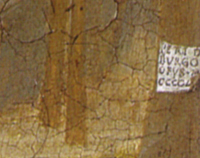 |
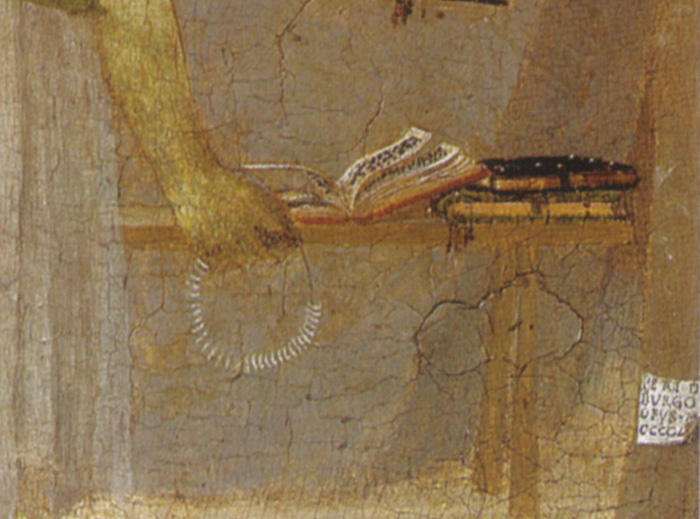 |
Piero della Francesca | St. Jerome in Penitence (detail), (c. 1449-1451) - Oil on panel, 51 x 38 cm, Staatliche Museen, Berlin
|

Art in Tuscany | Giorgio Vasari's Lives of the Artists | Piero della Francesca
Itinerary in Central Italy | In the footsteps of Piero della Francesca |
|
|
|
|
| |
|
|
This article incorporates material from the Wikipedia article Piero della Francesca published under the GNU Free Documentation License.
Wikimedia Commons has media related to Piero della Francesca.
|


Holiday accomodation in Tuscany | Podere Santa Pia | Artist and writer's residency
|
| |
|
|
|
|

. |
|
|
Podere Santa Pia |
|
Podere Santa Pia, garden view, April |
|
View from Podere Santa Pia
on the Maremma hills |
| |
|
|
|
|
|
|
|
|
|
Villa I Tatti |
|
Perugia |
|
Arezzo, Piazza Grande |
| |
|
|
|
|
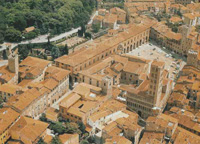
|
|
|
|
|
Arezzo |
|
Piazza della Santissima Annunziata
in Florence |
|
Florence, Duomo |
| |
|
|
|
|
'According to tradition, St Jerome was born around 340 in Stridon, modern-day Sdrin in Croatia, a scion of a prosperous and Latinised dynasty of merchants, predestined for great worldly success. After a sinful pagan youth in Rome and Trier, Jerome was converted to Christendom in 365. During his subsequent stay in high papal circles in Rome, he devoted himself to translating the Bible from its original Greek and Hebrew into Latin (and therefore popularising Holy Scripture). It is to the titanic labour of this Vulgate that Jerome owes his canonisation. Partly under the influence of his friendship with that other Father of the Church, St Gregory of Nazianzus, he withdrew shortly afterwards to live an ascetic life in the barren and desolate wilderness of Syria, where he wrote a short biography of the first hermit, St Paul - not the apostle Paul, but Paul of Thebes ( c. 230-340), the first Desert Father and presumably the originator of the eremitic ideal. Endless discussions could be held about the historical accuracy and authenticity of this saint's life - in which Jerome flatly opposed the generally accepted belief that not St Paul but St Anthony had been the founder of the ascetic rule - but what is more important is that Jerome turned this inspired piece of hagiographic prose into a manifesto for his own choice in life, which would have a much greater impact, in the long term, than Athanasius's Life of St Anthony , which was immensely popular at the time. That is amply illustrated by the fact that neither Athanasius nor Anthony ever made it to the same iconic status as St Jerome, whose patronage of writers and scholars, librarians and archivists, students, translators and exegetes, exiles, seekers and loners, would lead to an impressive array of historical depictions and galleries full of portraits.
(...)
Giotto, Masaccio, Botticelli, and Piero della Francesca all immortalised St Jerome as a penitent in the barren desert or as a studiosus maximus at his desk.' [Dieter Roelstraete Brussels, In the Beginning, there was St Jerome, May 2003] |
|
|
| |
|
|
|
| |
|
|
|
| |
|
|
|
| |
|
|
|
| |
|
|
|
| |
|
|
|
![]()







